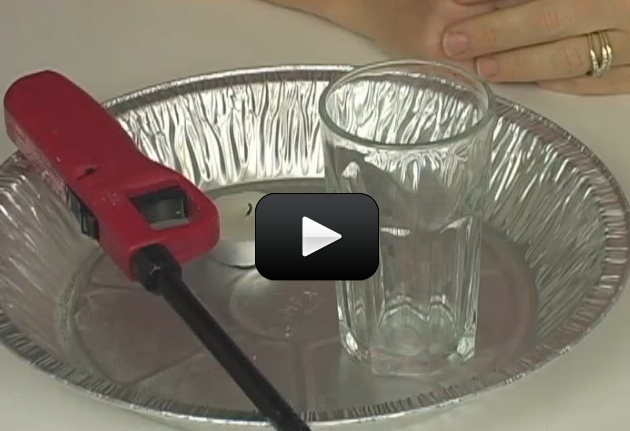This experiment not only explains how your body uses oxygen, but it is also an experiment in air pressure circles – bonus! You will be putting a dime in a tart pan that has a bit of water in it. Then you will put a lit candle next to the dime and put a glass over the candle with the glass’s edge on the dime. Once all of the air inside the glass is used up by the candle, the dime will be easy to pick up without even getting your fingers wet! Ready to give it a try?
[am4show have=’p8;p9;p29;p56;p81;p87;’ guest_error=’Guest error message’ user_error=’User error message’ ]
Here’s what you need
-
- 1 aluminum tart pan
- 1 votive candle
- 1 box of matches
- 1 clear drinking glass, 12 or 16 oz.
- 1 dime
- water
- 1 pair of goggles
- Adult supervision!
Download Student Worksheet & Exercises
Here’s what you do
- Pour about ¼ inch of water in the pan and place the dime right in the middle.
- Position the candle next to the dime and ask an adult to light it for you
- Put the drinking glass over the candle with its edge resting on the dime. Watch closely to observe what happens.
- Once the water is inside the glass, you can carefully remove the dime from under its edge. If done properly, the water will stay in the glass.
What’s going on?
When you put the glass over the candle, you created a closed system. The candle only had the gas trapped inside the air beneath the glass to burn. As the candle burned, the gases in the glass burned as well. They were transformed from a state of gas to a very compact solid state that stuck to the wick of the candle (this is why the wick gets black when a candle burns).
An important thing to note is that as the air was removed, the pressure inside the glass was reduces. Lower air pressure inside your closed system created an imbalance with the regular air pressure on the outside of the glass. Since there was more pressure on the outside, the water was pushed inside the glass. The dime helped to make a gateway for the water to be more easily pushed into the glass.
This lab serves to illustrate that oxygen is consumable. It’s the same thing that happens inside your body, but at a much slower rate that what you witnessed with the candle. Your lungs contain about 1,490 miles (2,400 km) of air passages to help absorb oxygen. If they could be spread out flat, an average set of lungs have a surface area of approximately 650 square feet. The sheer size of this system gives you the chance to absorb all the oxygen that your body needs.
Exercises
- What do we mean when we say that oxygen is consumable?
- What is the difference between an open and a closed system?
- Where is the higher pressure in this experiment?
- Why does water rise inside the glass?
[/am4show]


Unless the room is completely vacuum sealed, air (and therefor oxygen) will still seep into the room. Even in a room that is air tight, the more imminent danger would be carbon dioxide poisoning. That would occur long before oxygen could be depleted enough to reach critical levels.
Why is it that in a room that is not near a door that leads to the outside, and in which people come and go and breathe, there is still oxygen in that room every time someone takes a breath? How long would it be until the oxygen runs out?
cool!
It’s kind of an old fashioned term to say a “book of matches”, so I’ll fix it… 🙂
Hi!. I think you meant a box of matches under ‘Here’s what you need’.
The water makes for a very slippery surface with low friction, so there’s more of a chance for that candle to slide. Think of how easy it is to slide on ice when there’s a layer of water on top of it.
Why did the candle move across the water inside the glass as it burned out?